
ABOUT:
This shrine is dedicated to the Alliance of fans, players, and personnel who were involved with the short lived league. It is also dedicated to my father. Goodbye and I love you.
My father and I started with the WLAF way back in 1991/2. We loved every minute of watching the San Antonio Riders. He took me to the games and it was an important bonding moment in my life. When the Alliance was announced in San Antonio I jumped in and bought season tickets for us. I thought it’d be a great way to come full circle. Unfortunately, he passed away in the early days of January 2019, due to complications from Lupus. In his place I brought friends and family members to the games to recapture those golden moments we had shared so long ago.
I was not disappointed in the AAF. It was quality football in the Spring and the whole package was top notch at an affordable price.

Led by some of the most respected football minds in the game, The Alliance of American Football is high-quality professional football fueled by a dynamic Alliance between players, fans and the game. Fans will be able to stream Alliance matchups live via the free Alliance app while accessing integrated fantasy options with real rewards — for themselves and the players they are cheering on. Players will have state-of-the-art protection on the field and ample opportunities off it. The Alliance will provide players a comprehensive bonus system, post-football career planning as well as counseling and scholarship support for postsecondary education. Founded by TV and film producer Charlie Ebersol and Hall of Famer Bill Polian, The Alliance features eight teams, under a single entity structure, playing a 12-week season kicking-off February 9, 2019 on CBS and culminating with the championship game the weekend of April 26-28, 2019.
-AAF.com
BACKGROUND:
Charlie Ebersol was in attendance at the first XFL game back in 2001. He remembered being excited for the league, but like so many of us, was disappointed in the execution of the product.
Fast forward to 2016. Ebersol creates his labor of love documentary, an ESPN 30 for 30 presentation on the XFL. Who knows how long the wheels were grinding in Charlie’s head, but he sure learned a lot from his father and picking brains of people involved with the XFL. With a lot of positive press buoying him along- he decided to gather investors and football minds around him and see what he could do.
Now what is not clear is if or when Charlie approached Vince McMahon about firing back up the XFL. Was it something that Vince decided to do based on what Charlie delivered him, or was it something that Vince planned to do all along? Did Charlie even approach him in the first place? Anyway, it’s all tied up in the courts now with another person who claims the AAF was half his idea, so it is pure speculation, until or if it ever comes out.
So technically- XFL 2020 got out of the gate first. Vince McMahon during the 30 for 30 on the XFL hints at a possible return, setting the football world abuzz. So in late January of 2018, Vince ambles up and fires the first Spring shot. The XFL and Spring football is back…. in 2020.
Charlie keenly then decides to get a jump on the XFL by announcing the AAF in March of 2018, for play starting in Spring of 2019- A full year earlier than the XFL 2020 bid. Every piece of information and news media is expertly timed to keep the AAF in the hearts and minds of its prospective fans.
Financing would be done in Series groupings initially over 10 years. Two major venture capital groups stepped forward: Founders Fund and The Chernin Group. All teams were centrally owned by the league offices with plans for spooling off the teams at a later date to interested investors. The league was not concerned with attendance and sales initially- as they had that 3 years of funding secured. The plan was that the league will burn through cash like a start up for 3 years, (but should be a viable product before then).
The AAF was to compliment the NFL- not compete. (In fact the long term idea was to serve as a feeder league.) The AAF was very careful to cultivate an air of professionalism. They strove to navigate around the murky waters of minor league and farm systems, because in football that is looked down upon with disdain.
If you look back at leagues like the WLAF and UFL, they weren’t taken seriously because of their minor league label. This was especially true with XFL 1.0 where this was code speak for sloppy football. In the past these league’s games and championships didn’t receive a lot of press, or worse were on the back page of the NFL section of websites. The AAF worked hard to be taken seriously, and get their best face out there to the media. They partnered with groups like Barstool Sports and gave interviews to SI and other publications. Pro Football Focus graded each game and player performance, adding to the air of respectability they were attempting to create.

8 franchises were selected in the interim, coaching staff and front office put in place, and players quickly signed based on their region. No draft was held, rather a territorial assignment was made. Each team name was carefully chosen to reflect the fan base the team would be a part of.

Players who made the AAF teams were to be paid fairly- but not extravagantly- on 3 year contracts. They could make more by ‘acts of service’. Players would earn tokens for their community work, fantasy positioning, and or activities that benefitted the league at large. These tokens theoretically could be cashed out for a bonus or other incentives.
An educational stipend was planned be paid out at the end of the 3 years as well to encourage players to continue or finish their college studies. For each year in the AAF, players would earn a year’s scholarship for post-secondary education. Some players such as Trent Richardson were even considered for future positions as ambassadors once the league saw stabilization.

At some point, it may have been decided that the AAF QB pool was not divided up fairly, so the league opted to balance out the teams by having a Quarterback Protect or Pick Draft. Josh Johnson was the overall #1 pick by the league.
Broadcast deals were struck- surprisingly with CBS, and a few other partners. The partners got to broadcast the games for free in the first year as a proof of concept while the AAF took on the entire overhead.
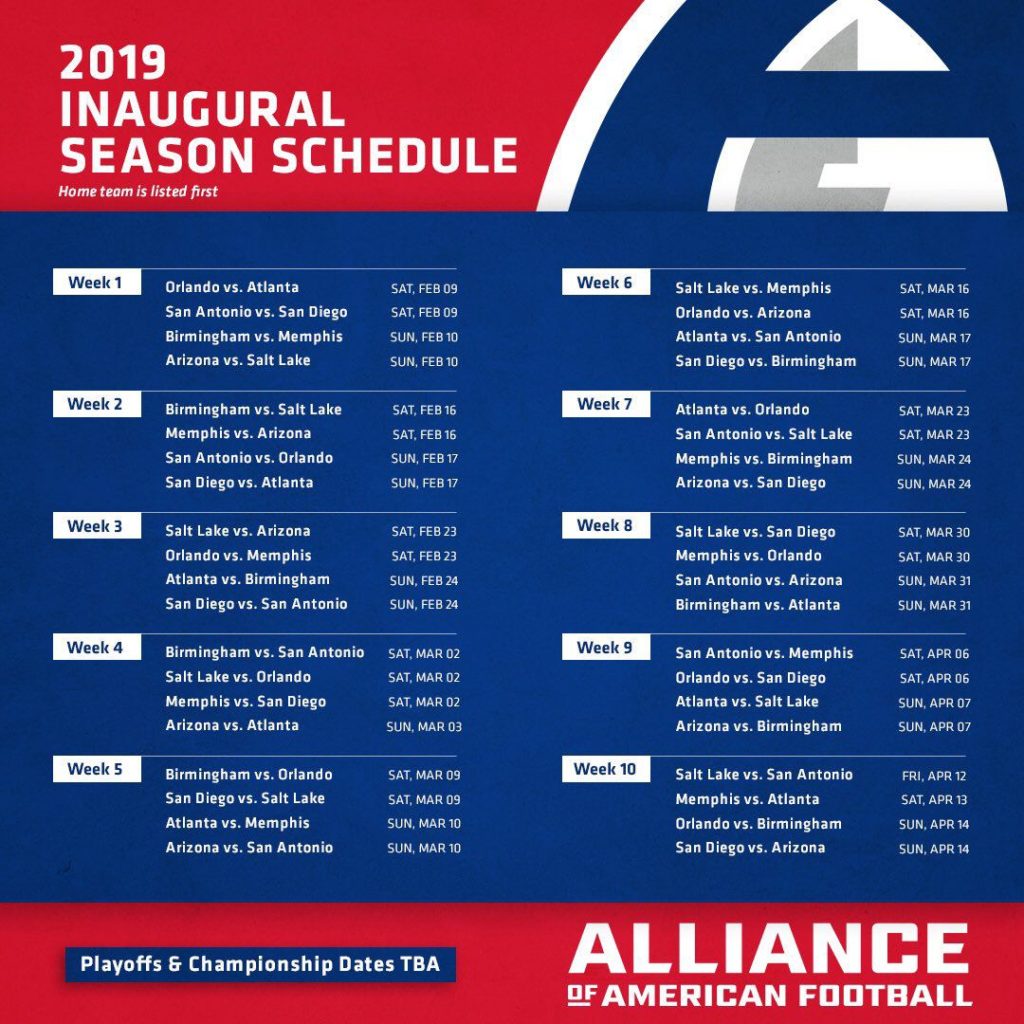
The league apparently survived 3-5 near extinction level events before entering the 2019 calendar year. Chief among them was the steadily waning cash flow from initial cash cow investor Reggie Fowler. It is also believed that in late 2018 the AAF approached the XFL about a merger or joint championship game. Curiously enough speculation was rampant that the idea was these two leagues could coexist in the Spring and compete against each other in a few years, much like the old NFL and AFL did. The leagues did not select the same city sites for teams- and rumor was Vince McMahon was unhappy that he couldn’t secure Orlando or San Diego before the AAF did.

The Alliance kicked off on February 9th 2019 to a surprising amount of fanfare. Not only was it well received, the AAF dominated social media, and even beat out the NBA game it went head to head with (Rockets v. Thunder). The games were fast paced, and fun to watch. Hits and plays were solid. San Antonio showed up with a larger crowd than expected for the AAF elite. The magic was working…
Then there was the news about the payroll.

Some people just want to watch it burn.
When it comes to startups, like this, there are just people who want to see you fail for a variety of reasons. Some just want to see you fail because well they want to be right. Especially in something like this where the odds are stacked against you, why bet against the house and take a chance at being wrong? That was the case with a lot of social media ‘journalists’ and pundits. At the drop of a hat, they’d report the nastiest and unfounded things they could, just to say they were first to the hot tip, and just to pat themselves on the back about the shambles of the league. Sure they call themselves ‘sports journalists’ but when they write negative opinion sports pieces or report only the negative aspects of your business, it turns from factual reporting into an opinion piece real quickly when you have a slant.
Who really knows if it was a payroll issue after the first game? Should it really have been an issue? – Again, another question to be answered not now/ maybe later/ or maybe never. It just seemed all too coincidental that at that moment, Reggie Fowler was out, and Tom Dundon was in.
It was later reported that Dundon’s interest in the league was sealed with Charlie Ebersol shotgun wedding style. It never was a fit from the beginning, as its been rumored that Tom had buyers remorse from the beginning- only looking at the financials and the prospectus after he dropped a $250 million dollar seed investment, was named CEO and took power over the board. Charlie meanwhile kept his Founder title and influence.
Dundon immediately started cutting costs and moved the championship game from Las Vegas to Frisco, Tx. Fans for the most part saw him initially as a savior of the league. Tom made statements about how his 250 million infusion was going to keep the league going. Things were quiet, but behind the scenes, bills were already not getting paid to vendors that existed from before the season began.
In the meantime, the AAF began negotiations in haste with the NFLPA. Charlie, Bill Polian, and Daryl Johnston, were among the high profile names involved with the talks. Things were moving slowly but it was progress, and the AAF was confident they could work something out. There were some concerns the NFLPA had over teams might possibly make their players go to the AAF for more seasoning. Then there was the whole Pandora’s Box of player injuries. Dundon in the meantime talked the talk, but quietly did he really understand what he got into?
Dundon spoke to USA Today and threatened the NFLPA, that if they didn’t work out a deal with the AAF, they’d he’d just shut down the league. Ebersol and Polian were floored. They had a 3 year plan. They went back to work with the NFLPA, and it appeared that the AAF and the NFLPA made some good headway- but by the conclusion of Week 8 it was already painfully over.
Players noticed that things were changing near the end. Stuff like group dinners were replaced by a small per diem, and players got a small bump in their paycheck at the end of the last week- which tipped the more financially savvy players off that something was amiss, but based on recent player revelations, these sort of shenanigans were going on all along.

That being said, it was rumored that Charlie was assembling a crew to stage a last second take back of the league from Dundon. Tom got word of it while on the golf course and decided to shut the league down right there.
The ensuing chaos is regrettable, but the league suspended operations officially on April 2nd 2019. Roughly two weeks later, the AAF filed for bankruptcy with Tom only spending a reported 70 million of his 250 million ‘commitment’.
LEAGUE TIMELINE:

KEY PROFILES:

CHARLIE EBERSOL
CEO/Founder

BILL POLIAN
Co-Founder

HINES WARD
Head of Football Development
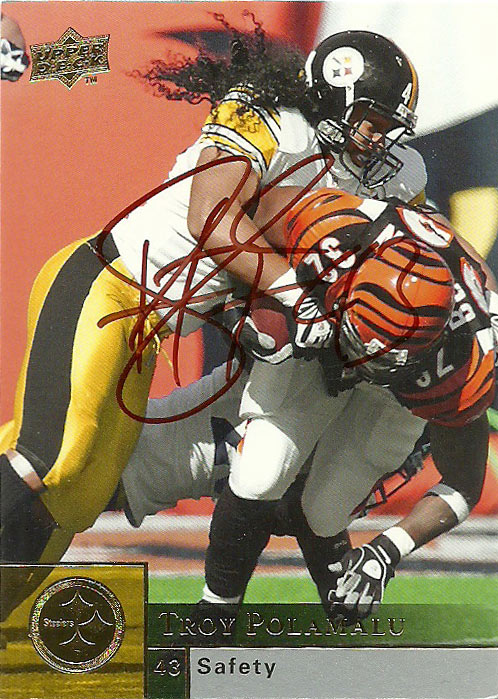
TROY POLAMALU
Head of Player Relations
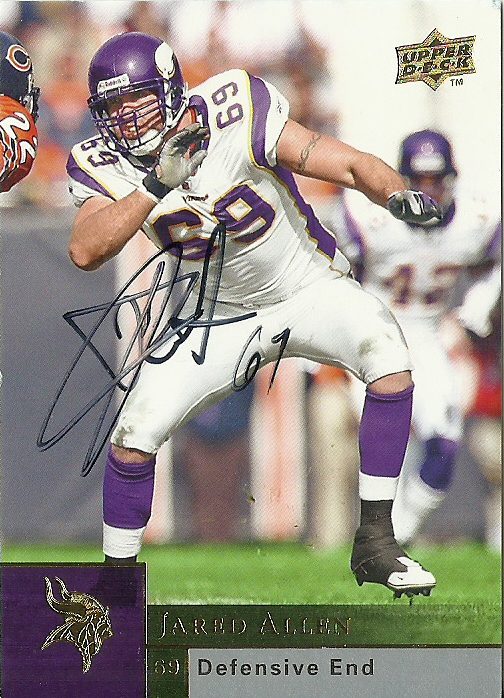
JARED ALLEN
Investor/ Player Engagement Board Advisor
INNOVATIONS:
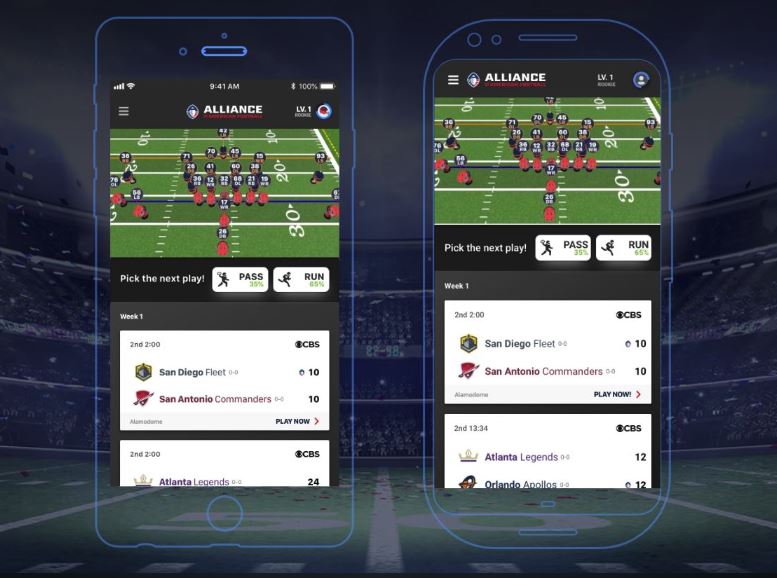
Gambling, fantasy football, scores, game videos, special unique interactivity for fans in attendance, news- everything essentially- was going to be in the AAF App. MGM liked the gambling idea so much they jumped on board for the tech. That being said, the App was released late and was stripped down. Some planned tech in the end never made it off the drawing room floor.
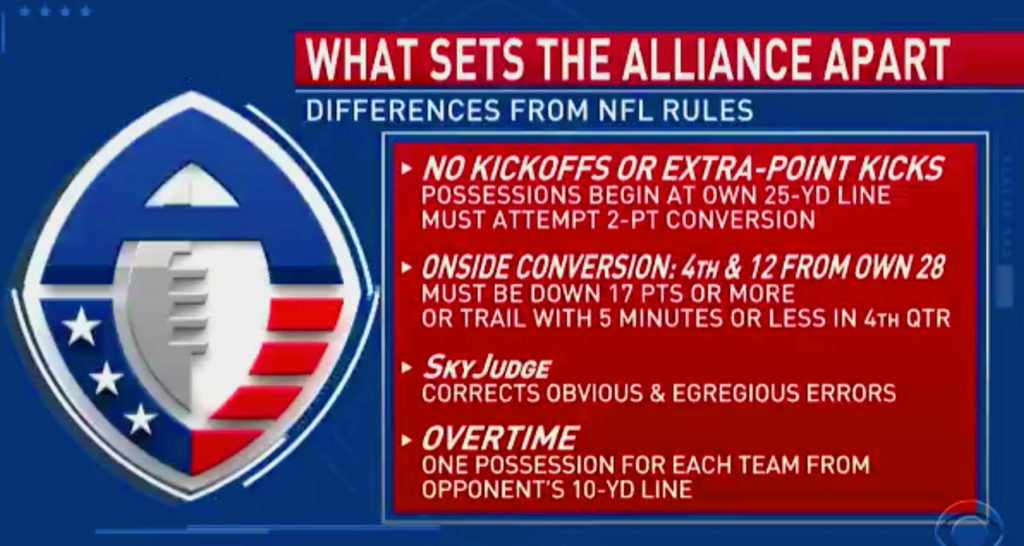
The biggest rule differences from the NFL had to do with kickoffs, extra points, and overtime, however the OT rules were only needed once during the entire duration of the league. The Sky Judge was added late, but only just before the season began, (after the NFL had a playoff debacle between the Saints and Rams.) The AAF also decided to utilize the 5 man rush system that the UFL had previously used to help offenses put up more yards. The AAF was also more lenient when it came to penalties, as quarterbacks were not coddled in the pocket, and players were encouraged to celebrate.
Games were scheduled to clock in under 2.5 hours and have 60% less commercials than their NFL counterpart.

The AAF football itself had an RFID chip inserted into the bladder of the ball, and made it capable of recording location, speed, and acceleration for every play during games. While the RFID chip has been nothing new to the NFL- who had been kicking around the idea since 2013 or so, and in the balls themselves (around 2016), the chipped ball was another example of the AAF’s commitment to technology.
“Wilson made 3 series of footballs for the AAF. We have the game ready series. About 200-300 balls were made. These have a zebra RFID chip sewn into the bladder. The chip can be located on the panel opposite the valve. You can feel it on the panel side opposite the valve. You’ll feel it because it’s more stiff. It’s about the size of a dime.”
“So the first iteration of the ball is the most rare. About 100 made. No chip. These were used for practice. The 200-300 were game balls with chip. The rest were collectibles for fans to buy. The league asked for the fan balls to be foil stamped with a team logo to avoid confusion. The order was never completed because the league folded, but they still have the stamp and die.”
– Seth Lessans
Football Ball Collector
via Amanda at Wilson Sports
TEAM PROFILES:

Team profiles will be updated regularly along with
player profile links.
NOTES:
Topps offered a series of Topps Now cards covering action every week throughout the season, however their regular AAF set
arrived very late in the season.
The AAF skirted the whole ‘flag issue’ by just keeping the players in the locker room until after the pledge. -Then came the team introductions. Fans were no worse for wear, or didn’t care. It was an ‘out of sight/ out of mind’ situation.
At one point, Coach Rick Neuheisel and Charlie Ebersol got behind an idea of quarterbacks picking their teams, like in the TV show ‘The Voice’, but Bill Polian didn’t understand it and when he did he wanted nothing to do with it.
The Alliance chased Colin Kaepernick but both his controversial profile and price tag scared the young league away. (Kaepernick wanted 20 million.) Steve Spurrier did his best to court Tim Tebow to come play for him and the Apollos but Tim wanted to focus on baseball.

The league moved the championship game early in the season from Sam Boyd Stadium in Las Vegas to The Star in Frisco, Tx due to poor ticket sales. My wife had given me the approval to go to the championship game, but the tickets were never put on sale, as the league folded shortly thereafter.
The last game was officially the San Antonio vs Arizona Hotshots tilt.
Since no league champion was crowned, Orlando at 7-1 put up a champions banner and named QB Garrett Gilbert league MVP. The competing Arizona Hotshots who had just beaten the Commanders, and had beaten the Apollos earlier that year, also crowned themselves champions as well.

LEGACY:
A bit over 50 players were signed to NFL rosters in a mini-free agent frenzy after the AAF collapsed. Some hit up the AFL and CFL, while many still await a call- hopefully from the XFL.
The AAF was not shy about hiring female coaches, with many of them quickly landing positions in other leagues after the Alliance collapsed.
Some people feel that the fans were really guinea pigs for the gambling tech that everybody is attempting to acquire now. It will form the foundation and serve as a learning tool for most sports gambling apps to come. Players and the game footballs were also tracked through RFID chips which helped the app globally pinpoint position each player on each play, (which is partially why you could never keep a football thrown into the stands).
The AAF had incredible, high quality, raw game feed free through their website, utilizing a unique 2 camera sky cam system. As many people were wired for sound to get fans closer to the action, and when plays were being reviewed, fans could watch the official in the booth help review the plays to see what thoughts were going into the decisions they made on calls.
The league paved the way for future leagues to utilize 30 second play clocks, which limited TV time outs and greatly improved the speed of the games. Many games concluded in about two and a half hours.

AFTERMATH:
The bones of the league are being acquired by the XFL at break neck prices. Helmets, locker boxes, playing tape, etc. Hopefully in some way it will serve as an affordable lesson to the XFL.
It was later disclosed that the fledgling MLFB put a bid in court slightly higher than the XFL’s original bid. At this time it is not clear who will secure the items at liquidation.
—
Wondering about those Venture Capital funds that promised to help? Well it turned out that Chernin Group and Founders fund may have only ponied up about 10 million- or less than a week’s worth of regular season operating costs.
—
One of the things to come out of the AAF after its dismemberment is that they were apparently really fudging their attendance numbers in some places. The Memphis Express’ contract with Liberty Stadium specified that for every ticket $1 was attached to it for a servicing fee, after the 2,500 complimentary tickets, so in order to get an accurate number you’d get the total revenue collected by Liberty Stadium and then add 2,500 to it to get the roundabout attendance. In many cases- these numbers were inflated.
But do we blame anybody for fudging the numbers? Leagues have been known for years to inflate ticket sales numbers. It’s like walking into a restaurant and if there’s nobody there, it doesn’t matter how good the food is, you just want to leave. Somehow you’ve got to get people interested and engaged with your product.
EPILOGUE TIMELINE
On June 25th, 2019 it was revealed that former CEO-President Tom Dundon was suing the league to recoup his $70 million dollar investment into the AAF.
It was also disclosed that indeed, the league was going to miss payroll without Dundon’s investment after the first week- and that it was not a ‘payroll glitch’ as previously speculated.
He claims that the prospectus was not up to date, that there was $13,000,000 in debt on the ledger, and that the league misrepresented itself on how much cash it needed to burn through the first season.
Personally I hope he wins in court, and in the grandest stroke of irony, he wins triple damages on $1.00.
—
July 1st, 2019- MGM has announced that they’ve reached an agreement to acquire the gambling tech that they invested in from the AAF for $125,000 and to reduce their claim in court by 2 million.
—
September 2nd, 2019- Of the 50+ AAF players who signed with the NFL 17 made it through training camp to place themselves on NFL rosters for the 2019 NFL season.
—
September 20th, 2019- Tom Dundon’s lawsuit has been referred to the bankruptcy court that is currently handling the dissolution of the AAF’s assets.
—
September 23rd, 2019- The player’s lawsuit filed by Reggie Northrup and Colton Schmidt has now also been referred to the bankruptcy court that is currently handling the dissolution of the AAF assets.
—
December 19th, 2019- In case you were wondering, the lawsuit filed by Robert Vanich is still moving forward in the state of California.
—
December 23rd, 2019- The AAF trademarks have shifted to a 606 Status -Abandoned – No Statement Of Use Filed.
—
January 9th, 2020- I finally got about to removing the AAF application as it no longer loads. Thankfully I pulled screens of all the games I could before it expired.
—
April 9th, 2020- Players are still waiting on their W-2s from the AAF.
—
May, 2021- At some point recently, the AAF website went officially offline.
—
September 2nd, 2021- The trustee from the court is seeking a settlement that drops Charlie Ebersol as a defendant to pursue an adversarial case against Dundon for 674 million. Of note, Ebersol has fully and candidly cooperated with the trustee of the court.
September 12th, 2021- Lawyers for the players, Charlie Ebersol and the Chapter 7 Trustee have asked a bankruptcy judge to approve a settlement giving players a priority wage claim of $13,650 in lost wages for the two games never played, plus 180k for the wages covering the final two years of the players original 3 year contracts.
—
October 6th, 2021- Bankruptcy proceedings continue for the AAF. Tom Dundon has objected to the players’ settlement agreement, and believes that he has a priority claim recovering his 70 million. His lawyers argue that the 5.6 million agreed to in the settlement should go to.. well… him. (Of note there is only 3.9 million approximately left in the remaining estate to pay out, according to Dundon’s counsel.)
—
November 30th, 2021- The AAF began sending players bankruptcy notices via email on how to recover lost wages.
—
April 26th, 2022- Reggie Fowler, the initial ‘angel investor’ of the AAF, who then later had cash flow issues, and had to bail on the league, (Feb 2019) was found guilty today of federal charges relating to crypto currency fraud and laundering.
—
November 15th, 2022- The AAF, the gift that keeps giving. Today the US Trustee overseeing the Bankruptcy proceedings of the league, sued Tom Dundon for at least $184 million, alleging he tanked the league when there were other financial options available to keep it afloat.
Dundon, turned around and sued former founder Charlie Ebersol for $70 million, alleging that Ebersol was not forthcoming with the financial status of the league.
Among the bombshells that were revealed by the trustee:
1) Dundon was approached by none other than NFL Commissioner Roger Goodell that the AAF was going in the right direction and would be a good investment.
2) NFL owners such as Robert Kraft had been silently going to bat for the league, putting together calls with potential investors to buy out Dundon’s stake in the AAF. Among those were Mark Shapiro, Ari Emanuel and Jeff Moorad.
3) Ebersol selected Dundon because he was willing to inject capital now, strings free into the league. (That was obvious.) But what was not, was the other potential investors that he turned down in order to secure the ‘best good faith deal’ from Dundon. Institutional investors such as JPM Chase had expressed interest in adding the league to its sports capital wing, as well as billionaire fund Andreessen Horowitz.
4) Instead of entertaining selling his investment, Dundon began to explore ways to write off the league for tax purposes through PriceWaterhouse Cooper- calling it ubiquitously ‘Project Football’.
5) Under the table on January 30th, 2019 the AAF had finalized a binding term sheet with the NFL, to spin out its tech to the NFL, and for the NFL to acquire a 15% enterprise stake in Ebersol Sports Media Group, the parent company of…. the AAF.
—
February 18th, 2024– Hungry for more AAF stories, I ran into Jason Mannix- who worked radio for the Commanders during the season. He told me the league was just blowing money left and right. They didn’t know how to manage it at all. For example, they’d fly him on a private jet all alone to broadcast a game, spend 4 hours there, and then they’d fly him back. The costs were astronomical compared to what they could’ve done if they had him fly budget and stay a night at a hotel.
Daryl Johnston also mentioned the Commanders during the UFL Brahmas open house. He told us that the team was on pace to break its own attendance record again, and in the end would have sold over 40,000+ tickets for their home game against Johnny Manziel and the Memphis Express.







